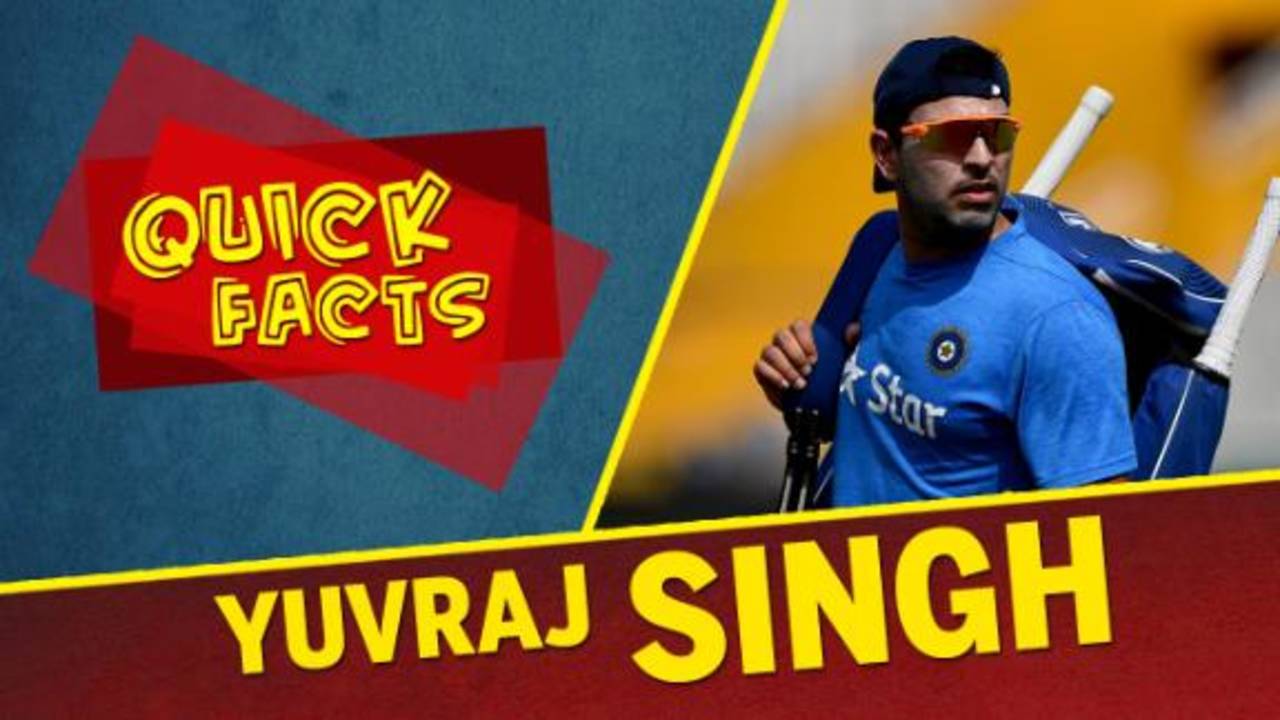Between his emotional return from cancer in late 2012 and a rain-affected
no-result in Centurion in December 2013,
Yuvraj Singh scored 278 ODI runs
at 18.53, with two half-centuries and four ducks in 16 innings.
That run of form prompted the selectors to leave him out of India's ODI squad for the tour of New Zealand in early 2014. That, it seemed, was that, for the hero of India's 2011 World Cup.
Except it wasn't. Three years on, at 35, Yuvraj
is back in the ODI squad, after a season of plenty in the Ranji Trophy: 672 runs in five matches, including scores of 260 and 177, at an average of 84.00.
It's a lovely story in some ways, another example of Yuvraj's determination to prove his days aren't done, and a selectorial call that reiterates the relevance of runs in first-class cricket. A BCCI source confirmed to ESPNcricinfo that Yuvraj's domestic form convinced the selectors of both his fitness and hunger to play 50-overs cricket.
"There haven't been too many limited-overs domestic matches, and we all know Yuvraj is a brilliant one-day cricketer," the source said. "The issue is whether he is lasting that long, whether he is fit and fine, that is the only issue. And, he has proved with his performance: when somebody can get 260 or 170, that means the hunger is there."
Hunger, though, has never really been an issue with Yuvraj. Since being dropped from the ODI team, he has consistently scored runs and made big hundreds in domestic cricket. He
averaged 55.91 in the 2014-15 Ranji season, scoring centuries in three successive matches, and while 2015-16
wasn't as productive, it brought him
a 233-ball 187 against Gujarat. In the time he's spent out of the ODI squad, he's never made anyone doubt if he can last the duration of a first-class game or if he can still destroy first-class attacks.
The reason why India dropped Yuvraj in the first place was his ability against high-quality international bowling. It had never been in doubt - in limited-overs cricket, certainly - in his pomp, but the Yuvraj of 2012-13 never really looked at home against the very best. During an ODI series against Australia in 2013, he made 19 runs in four innings at 4.75, and was out three times to Mitchell Johnson, in three different ways - bounced out in Pune, nicked off in Mohali, and bowled by a full, straight inswinger in Nagpur. Each time, Yuvraj looked half a beat late on the ball.
While ignoring him in ODIs, the selectors continued picking Yuvraj for T20s. He played all of India's matches in the 2014 World T20, and would probably have done the same in 2016 had he not twisted his ankle while batting against Australia in Mohali. He struggled in both tournaments, as his strike rates - 98.03 in 2014 and exactly 100 in 2016 - would suggest, and it was a surprise that he was back in the 2016 squad after the ordeal he underwent in the 2014 final, and the
undeserved lampooning that followed. That Yuvraj was still part of the T20 squad two years later was testament to his own self-belief and to selectorial wrong-headedness.
It's staggering, therefore, that he's back, again, and not just in the T20 squad but for the ODIs as well. Going back to Yuvraj would be a fair call if Indian cricket were struggling to produce young batsmen. That, though, is simply not the case.
Mandeep Singh, Yuvraj's Punjab team-mate, was part of India's last ODI squad, didn't get a game, and now finds himself left out.
Karun Nair scored a triple-hundred in his last Test match, and is an IPL regular. As is Rishabh Pant, who is coming off a sensational Ranji season in which he scored 972 runs at an average of 81.00 and a strike rate of
107.28, with four hundreds including a triple. Shreyas Iyer averages over 50 and strikes at nearly 80 in first-class cricket.
Mandeep and Pant are part of the T20 squad, but as the chief selector
himself confirmed, his panel picked a youthful T20 squad chiefly because there is no major tournament in the immediate future. The ODI situation is different, with a Champions Trophy five months away.
The selectors, in all probability, did not recognise the irony of choosing Yuvraj as the experienced batsman ahead of younger contenders. For it was in the Champions Trophy - then known as the ICC Knockouts - that Yuvraj made his debut. The tournament came nine months after the Under-19 World Cup of 2000, in which Yuvraj had been one of
the leading lights of a triumphant Indian team.
He had done well enough in that tournament for the selectors to throw him into the deepest possible end - a world tournament. The current selection panel has picked a 35-year-old Yuvraj over a number of young contenders - some of whom, such as Mandeep and Pant, have played for India's Under-19s - when the stakes are not as high. The Champions Trophy may be on the horizon but India, for now, are only playing a bilateral series.
When he made
that 84 against Australia in his first international innings, Yuvraj was still a couple of months shy of turning 19. Here's something to ponder: would the selectors responsible for picking him in 2017 have picked him in 2000?

